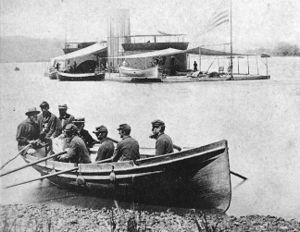USS Onondaga (1864)
| 300px USS Onondaga at anchor on the James River, Virginia, during the American Civil War, circa 1864-65. | |
| Career (USA/France) | 100x35px |
|---|---|
| Name: | USS Onondaga |
| Namesake: | A lake and county in New York. |
| Ordered: | 26 May 1862 |
| Builder: | Continental Iron Works, Greenpoint, New York |
| Laid down: | Unknown |
| Launched: | 29 July 1863 |
| Sponsored by: | Miss Sally Sedgwick, daughter of former U. S. Representative Charles Baldwin Sedgwick |
| Commissioned: | 24 March 1864 at the New York Navy Yard |
| Decommissioned: | 8 June 1865 at Philadelphia, Pennsylvania |
| Maiden voyage: | New York City to Hampton Roads, Virginia |
| Struck: | 1865 (est.) |
| Fate: | Sold 7 March 1867 to her builder, G. W. Quintard and subsequently resold to France for service in the French Navy under the same name. Scrapped c.1904 |
| General characteristics | |
| Class and type: | Onondaga |
| Type: | Monitor |
| Displacement: | 2,592 tons |
| Length: | 226 ft (69 m) |
| Beam: | 49 ft 3 in (15.01 m) |
| Draft: | 12 ft 10 in (3.91 m) |
| Depth of hold: | 13 ft 2 in (4.01 m) |
| Propulsion: | Steam engine |
| Speed: | 9 knots (17 km/h) |
| Complement: | 150 officers and enlisted |
| Armament: |
2 × 15-inch Dahlgren smoothbores 2 × 150-pounder Parrott rifles |
| Armor: |
Turrets: 11.75 in Pilothouse: 11.75 in Hull: 5.5 in Deck: 1 in |
USS Onondaga (1864) was a monitor acquired by the Union Navy during the American Civil War. Onondaga spent her entire active career with the James River Flotilla, covering the water approaches to Richmond, Virginia, during the Civil War's last year. Post-war she was purchased by France and placed in service as a French naval vessel.
Contents
American Service
Constructed in New York
Onondaga – the first U.S. Navy ship to bear the name – was a double turreted monitor launched 29 July 1863. She was smaller than the twin-turreted Miantonomoh class monitors constructed at about the same time. Onondaga was somewhat unique in that her hull was constructed entirely from iron at Continental Iron Works, Greenpoint, New York, under subcontract from George W. Quintard who also produced her engines at his neighboring Morgan Iron Works. She was sponsored by Miss Sally Sedgwick, daughter of former U.S. Representative Charles Baldwin Sedgwick, who codified naval laws for the Navy Department; and commissioned at New York Navy Yard 24 March 1864, Captain Melancthon Smith in command.
Assigned to the James River flotilla
With Mattabesett, the new monitor departed New York, New York, 21 April 1864, and arrived at Hampton Roads two days later. Operating primarily in the James River Flotilla, Onondaga supported General Ulysses S. Grant's drive on Richmond, Virginia. On 24 November with Mahopac she engaged Southern batteries on the James River at Howlett’s Farm, Virginia, and resumed the attack 5 and 6 December.
Early in January, much of the Union strength was withdrawn from the James River as Rear Admiral David D. Porter assembled his powerful fleet for the forthcoming attack on Fort Fisher, which protected Wilmington, North Carolina. Onondaga was the only monitor left to guard Union forces on and along the James against Flag Officer John K. Mitchell’s Confederate James River Squadron.
When the Southern force steamed down river to attack the weakened Union forces there afloat, the monitor dropped downstream to a position affording her greater maneuverability. She and her supporting gunboats awaited the Southern attack only to have the Confederate thrust blunted when Mitchell’s ironclads Virginia II and Richmond, gunboat Drewry, and torpedo boat Scorpion all ran aground trying to pass obstructions at Trent's Reach. After attacks by Northern shore batteries and Onondaga, Drewry exploded, Scorpion was abandoned, and the two Southern ironclads withdrew upriver when they were refloated the next day.
Final war operations
After continuing to support Union troops fighting to take the Confederate capital until General Robert E. Lee was forced to abandon Richmond, Onondaga steamed north and decommissioned at New York City 8 June 1865 and was laid up at League Island, Pennsylvania. By Act of Congress approved 7 March 1867, the monitor was sold to her builder, G. W. Quintard and subsequently resold to France for service in the French Navy as the Onondaga.
French Service
Onondaga had a long career as a unit of the French Navy, retaining the historic name Onondaga. She was rearmed in French service, receiving 9.4-inch rifled guns in place of her U.S. battery of 8-inch Parrott rifles and 15-inch Dahlgren smoothbores.
Onondaga, whose iron hull helped to make her the longest-lived of the larger American-built Civil War era monitors, was scrapped in 1903-1904.
References
This article includes text from the public domain Dictionary of American Naval Fighting Ships. The entry can be found here.
See also
External links
- Pages with broken file links
- Wikipedia articles incorporating text from the Dictionary of American Naval Fighting Ships
- Ships of the Union Navy
- Ships built in New York
- Monitors of the United States Navy
- United States Navy steamships
- American Civil War patrol vessels of the United States
- New York in the American Civil War
- 1863 ships
- Monitors of the French Navy

